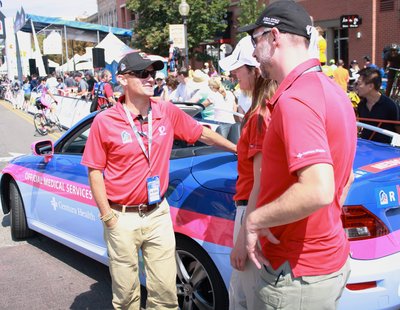
Doctor's Orders: How Centura Health Stitches the Peloton Up
Crashes happen every day at the USA Pro Challenge. Centura Health's medical team stitches the riders back together.
I f you race bicycles long enough, you’re going to crash. And if you race professionally, you are guaranteed to hit the pavement multiple times each year.
f you race bicycles long enough, you’re going to crash. And if you race professionally, you are guaranteed to hit the pavement multiple times each year.
Crashing is an unfortunate inevitability in bicycle racing, even at major events such as the USA Pro Challenge. Every day, at least one rider skids out in a corner, bumps into a guardrail or falls in the peloton.
Luckily, the USA Pro Challenge works with Centura Health, which supplies a dozen or so doctors, physical therapists, nurses and emergency personnel for each stage. Centura even provides a Flight for Life helicopter throughout the race week.
Overseeing the medical team is Medical Director Jeff Huber, who works as trauma physician’s assistant at St. Anthony’s Hospital in Lakewood. Huber rides behind the peloton in a pink Lexus convertible, which serves as the medical car.
After a crash, a rider will hang onto the car while Huber performs an evaluation. If the crash caused head trauma or a broken bone, Huber decides whether or not the rider should stop and board one of the trauma ambulances.
“All of the riders want to keep racing,” Huber says.
If a rider is unable to remount his bicycle, an ambulance crew is on hand to rush him to the hospital. If the rider escaped with minor cuts or road rash, Huber applies bandages while the rider hangs onto the car.
“It’s definitely an adrenaline rush to lean out of a car and apply bandages to a contusion at 30mph,” Huber says. “I’m usually just doing stuff to stop the bleeding.”
During stage 6, United Healthcare rider Danny Summerhill crashed on the descent from Rist Canyon. After remounting his bicycle, Summerhill rode alongside the medical car. Huber said he was most concerned about head trauma. He asked the cyclist a series of questions to determine whether Summerhill had suffered a concussion.
Summerhill responded coherently to the questions, so Humber applied first aid. He cleaned a cut on Summerhill’s knee, and fixed bandages. Summerhill was able to complete the stage. After the finish, Huber stitched the cut on his knee.
“He’ll finish the race,” Huber says. “That’s pretty common.”
Less common are crashes that require emergency attention or evacuation. In 2014, Jamis rider Ian Crane suffered life-threatening head trauma after crashing into the back of a race vehicle while chasing after the peloton. The crash was the worst in the history of the race.
Huber said medical staff applied life-saving treatment to Crane shortly after the crash, and within minutes, a Flight for Life helicopter was on the scene. Just 30 minutes after impact, Crane was at the hospital.
A year after the impact, Crane is still recovering from the crash. But the quick work of the medical staff likely saved his life.
“We over prepare ourselves, and hopefully we don’t have those situations,” Huber says. “And if we do, we can be ready.












